We have moved away from the clinic-based philosophy and only work in the child’s natural environments. This is based on the latest research in early childhood intervention that has found that this approach is best practice.
We come to your home, meet you at your local park, join you on a shopping trip – whichever setting presents your child with challenges.
Why are visits in the child’s natural environments more effective?
There are the obvious benefits such as convenience for the family:
- one less time to get everyone in the car on time to go to some other place – we come to you
- no need to arrange for a babysitter for the other kids – we work with your whole family
- less disruption of your family routines – we use your daily routines to shape the session
And then there are the therapeutic benefits:
- it is a familiar environment where your child feels secure to explore and learn new skills
- activities are meaningful to the child making learning easy and fun
- strategies are explored within the actual setting ensuring that adjustments, customisations and adaptations actually work.
- no more frustration because skills practised in the clinic is not transferred to the actual situation
- you as the child’s caregivers are actively involved in the visit, upskilling you to give your child the most stimulating environment to grow up in.
- learning opportunities are created during daily routines providing you with multiple and frequent opportunities to support your child’s development child throughout the day – whether it is during nappy changes, bath time, while travelling in the car
How frequent are visits?
This is your choice. Your decision may depend on financial resources, or on a specific time frame (e.g. your child is going to school), the acuteness of the child’s area of challenge, the time you have to practise the strategies between visits.
The average for home visits tends to be fortnightly for initial visits. Towards the end of our working together you may only want to touch base with your therapist every couple of months.
What does a visit look like?
A visit may involve any of the following:
- sharing what has been happening since the previous visit, including new successes and challenges
- deciding together what we would like to achieve during the visit
- we may share some information – you as the caregiver may share about your child, e.g. about what you have tried, what has worked, and what has not, and your therapist may share information, for example about developmental milestones, what strategies can be tried, what environmental modifications can be made
- we may try out some ideas that we both think should fit with your child’s interests, his level of development, etc.
- the therapist will model any novel strategies and once you feel confident give you the opportunity to give it a try.
- we will evaluate what has worked well and together come up with a plan about what our next steps will be.
How long is a visit?
Once again that is something you decide. We generally find that an hour to 90 minutes works well.
What if it is not possible to have a visit at my home?
We realise that it is not always possible or convenient for families to have a visit at their home. We therefore offer families the option of sessions at our site in Highett.
